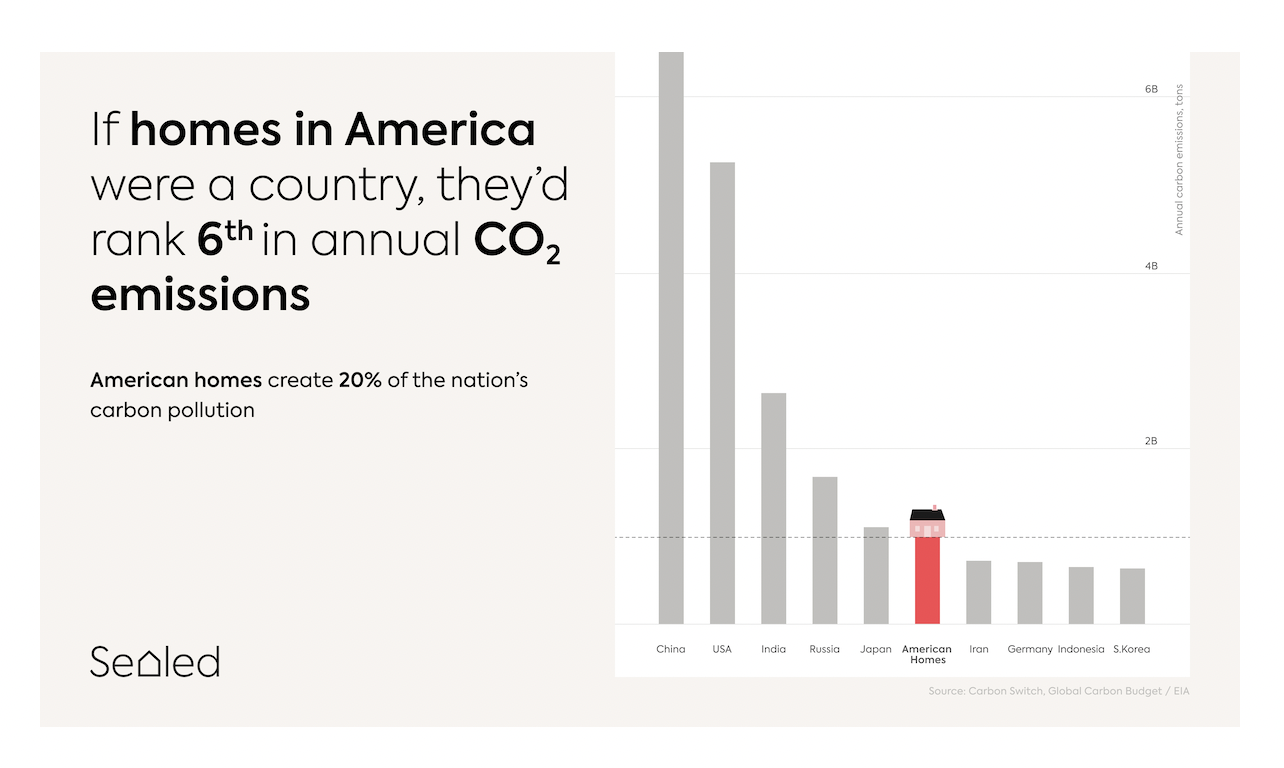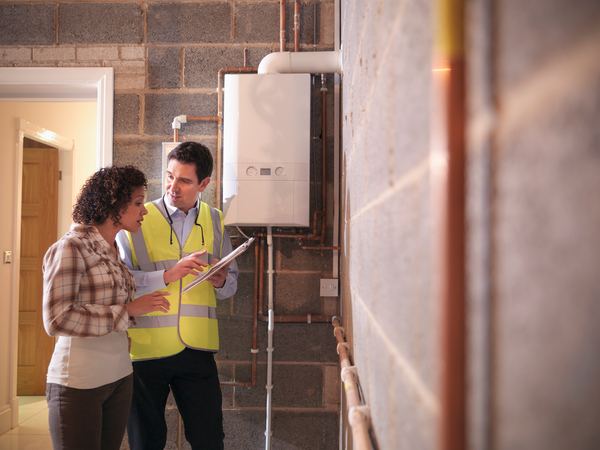Discover practical ways to make a difference in carbon emissions in your own house.
When it comes to reducing your carbon footprint at home, every little bit helps.
Changing your behaviors and adopting new habits like recycling or buying sustainable, earth-friendly products can be a great first step toward making a difference in global warming.
Even with growing climate change concerns, there’s good news: You can make a difference. And if you’re a homeowner, an essential piece to reducing your and your family’s environmental footprint lies inside your house itself.
Get a custom plan to decarbonize your home—at no upfront cost. Tap here to see if you qualify.
Table of contents
- What’s a carbon footprint?
- Reducing carbon footprint at home: Why it’s important
- 15 ways to reduce your carbon footprint at home
- How to get an expertly crafted home energy efficiency plan—and upgrades at $0 upfront
Key points in this article:
- Definition of carbon footprint: You create carbon emissions through everyday activities like driving, washing clothes, cooking, and heating or cooling your home. The amount of carbon emissions you create is your carbon footprint.
- The 6th largest emitter of carbon in the world is American homes—like, just American homes. Homes in the United States emit more carbon than the entire country of Germany (1).
- You can reduce your carbon footprint at home by making changes that benefit the planet–ones that pay off in the long run in other ways (like your home’s value).
- With Sealed, qualifying homeowners can get an expertly crafted plan to reduce their house’s carbon footprint in some of the biggest energy-wasting areas of homeownership—and at no upfront cost.
What’s a carbon footprint?
First off, let’s get some definitions out of the way.
Your carbon footprint is the amount of carbon emissions or greenhouse gasses created or emitted by your everyday actions.
Every single one of us has a carbon footprint—every human, machine, plant, and animal has a part in carbon emissions or carbon reduction.
How your home plays a big part in your carbon footprint
While you might already know that vehicles or big companies have a role to play in greenhouse gas reduction, your house does, too. American homes are the sixth largest carbon emitter in the world (2). But how?

Houses contribute to greenhouse gasses in plenty of ways, but here’s a quick example: When your HVAC system heats and cools your home by using energy (especially fossil fuels like natural gas or oil), your house emits carbon dioxide.
In fact, you can check out this home carbon emissions map to see how much carbon your house emits on average.
It’s important to reduce your carbon footprint—both in your house and household activities—because doing so helps protect, sustain, and even repair our planet.
But reducing your carbon footprint at home doesn’t require a lot of work or scientific know-how. Let’s dig in.
Check out our comprehensive guide for 52 of the best ways to conserve energy at home.
How to reduce your carbon footprint at home: 15 ways to lower emissions
Making changes to reduce your carbon footprint doesn’t have to feel like a huge sacrifice, and in fact, some of these shifts can increase your home’s resale value.
Here’s a high-level look at 15 ways you can lower greenhouse emissions at home, and we’ll discuss each one in more detail below.
- Get a home energy audit.
- Air seal and insulate your house.
- Plant trees in your area (or sponsor tree-planting organizations).
- Invest in a heat pump clothes dryer.
- Upgrade to high-efficiency home appliances.
- Switch to energy-efficient HVAC (heat pumps are recommended!)
- Swap oil and natural gas heat for clean energy.
- Drive an electric car.
- Upgrade to a heat pump water heater.
- Switch to a clean energy provider in your area.
- Wash your clothes in cold or warm water. (Not hot!)
- Plant native plants in the garden.
- Use natural cleaning products whenever possible.
- Install a smart thermostat.
- Embrace the power of the sun with solar.

1. Get a home energy audit.
Start here! One of the simplest ways to start on the path to reducing your carbon footprint at home is to get an energy audit. Many utility companies provide this service at a low cost—or even for free!
A professional energy audit is the first step to knowing all of the areas of your home that are causing energy waste problems—and your energy auditor will likely make many of the recommendations we’ve listed below.
(Keep in mind, energy waste usually equals high energy bills. Read Why are my energy bills so high? to learn more.)
2. Air seal and insulate your house.
Okay, so it’s pretty likely that your energy auditor will recommend air sealing your house and upgrading your insulation—unless you live in a brand-new house or recently had this work done.
Adding insulation and air sealing can make your house significantly more efficient: It’ll stay warmer in winter and cooler in summer while using far less fuel.
How do we know? Because professional air sealing and upgraded insulation are the best ways to solve a whole host of energy and comfort-related problems in your house.
These two home improvements work together to create an effective thermal boundary for your home, making your existing HVAC system way more efficient too.
(And you can get these home improvements at no upfront cost with Sealed if your house qualifies.)
3. Plant trees locally or sponsor tree-planting organizations.
One of the most powerful ways to reduce your carbon footprint at home is to actively work to reduce your impact and repair the environment at the same time.
So even if you have trees in your neighborhood doing the good work of breaking down CO2 into oxygen, their numbers are in decline.
In a study published by Urban Forestry & Urban Greening, scientists estimated that in the 5 years between 2009 and 2014, the U.S. lost approximately 36 million trees (or 175,000 acres of tree cover) per year (3).
Planting native trees in your community, or donating and sponsoring tree planting organizations, can go a long way to reduce your carbon footprint in your community.
Getting hassle-free home energy upgrades with Sealed could be the equivalent of 6 cars off the road, 1000+ bags of recycling, 35 acres of preserved forest.
4. Invest in a heat pump clothes dryer.
Heat pump dryers recycle the air that typically goes out of your dryer vent. By reusing heated air, these dryers require much less energy—and they’re also gentler on your clothes.
Heat pump clothes dryers have been growing in popularity over the past few years in the United States, leading to lower prices and more models from manufacturers. So if you’re already shopping around for a new dryer, consider making the switch to one that operates via a heat pump.
5. Upgrade to high-efficiency home appliances.
Older appliances can be energy hogs.
According to the U.S. Energy Information Administration, refrigeration makes up about 3% of your home’s energy use and all other energy used in the home by smaller appliances (including TVs, computers, laundry, cooking, and more) makes up about 21% (4).
Refrigerators can be one of the biggest energy users because, well, you know the joke: They’re always running.
Look for ENERGY STAR options, which could be 30% or more efficient than your old icebox. Use the ENERGY STAR Product Finder if you need a hand shopping around for energy-saving options.
6. Switch to energy-efficient HVAC.
At Sealed, we’re a little biased in our HVAC preferences.
Still, science backs us up: an electric air source heat pump is one of the most energy-efficient HVAC systems, and one that is flexible enough to work in a variety of climates and home types.
Over half (51%) of the energy used by the typical home goes into heating and cooling alone!
U.S. Energy Information Administration
Electric heat pumps work to both cool and heat your home—and they make your house feel amazing while delivering up to three times more heat energy to a home in winter than the electricity they need to run (5).
But heat pumps cool your home in summer, too! They’re an all-in-one smart-tech HVAC solution, which is why we affectionately call them the Tesla of HVAC.

7. Swap oil and natural gas heat for clean energy.
If you’re still using fossil fuel heat, switching to geothermal or electric heat from air source heat pumps can help reduce your carbon footprint.
Use heating oil? Not only does oil heat release 3 times more carbon pollution into the air than gas and electricity, but it’s also inefficient (6).
Oil heaters typically have an efficiency rating of 85% or less, and performance degrades over time, which means that they can waste up to 30% of the fuel they burn.
That’s why converting from oil to an electric heat pump is an excellent change for reducing the greenhouse gas emissions your house produces. One you can make at no upfront cost if your house qualifies.
Another benefit of switching? Natural gas prices are rising (energy, in general, is getting more expensive), and making energy efficiency upgrades can help.
Read Why is natural gas going up? to learn more. And tap here to learn the pros and cons of converting from gas heat to an electric heat pump.
8. Drive an electric car.
Having a car is necessary for many, and switching to electric makes a huge difference. If public transportation, walking, or biking won’t get you there, an electric vehicle can help spare the air.
A typical gas vehicle emits about 4.6 metric tons of carbon dioxide per year, and in general, highway driving releases over 1 billion tons of greenhouse gasses annually (7, 8).
While not everyone may be in the market for a new car, if you are ready for a new set of wheels, consider making the change to electric to reduce your carbon footprint.
9. Upgrade to a heat pump water heater.
According to Energy.gov, heat pump water heaters can be 2–3 times more energy-efficient than other water heaters (9).
And while tankless water heaters are nifty technology and are pretty popular due to their small footprint, they actually aren’t as energy efficient as a heat pump water heater. So make sure to do a thorough comparison before you decide what’s best for you.
10. Switch to a clean energy provider in your area.
As a utility customer, in many areas, you can now choose to purchase clean energy from your utility.
To make the swap, visit your utility’s website for instructions (but it’s likely that you’ve received a few pamphlets in the mail about it already).
11. Wash your clothes in cold or warm water. (Not hot!)
This carbon-footprint-reducing suggestion doesn’t require much effort at all, just a simple switch.
Most modern laundry soaps and washers are advanced enough to get your clothes squeaky clean without the added use of hot water. And cool water is gentler on your fabrics and can make your clothes and linens last longer—reducing even more waste.
Want more energy-saving tips? Tap here for the best ways to save energy around the house.

12. Plant native plants in the garden.
Love to garden? Even if you’re working with just a few small flower beds for curb appeal, growing native plants can help reduce water usage to keep your landscaping alive.
And if you’re ready to go all-in, trade in the lawn chemicals and sprawling green for native plants and trees.
Reducing your water use and chemical care often required to keep non-native plants thriving can help lower your carbon footprint.
13. Use natural cleaning products whenever possible.
What most people don’t realize is that a simple vinegar, rubbing alcohol, and water solution can do the trick in a variety of cleaning and disinfecting situations.
And by using a reusable spray bottle and bulk-purchased supplies, you can reduce your single-use plastics at home and keep harmful chemicals from polluting your home’s air quality and your community.
14. Install a smart thermostat.
Ah, the simple power of a smart thermostat. Installing one of these babies can cut your home’s energy waste (and your carbon footprint) without much work on your end.
Smart thermostats learn the temperature preferences of your household, so they adjust the temperature automatically based on the time of day—keeping you more comfortable and reducing energy use when you’re not home.
15. Embrace the power of the sun with solar.
Thinking about going solar? Depending on where you live and what your utility offers, you can switch to using solar energy even if you don’t install solar panels on your own roof. (Yes, it’s true!) Check out EnergySage.com to learn how to purchase solar energy from people who are generating it in your area.
Also, switch to solar wherever you can. You can invest in a solar generator that offers backup battery power for your home (and that’s powered solely by the sun) like EcoFlow, so you can ditch that dinosaur of a backup generator that runs on gas and produces harmful fumes.
If you decide to install solar panels on your home, go you! Not only are they one of those energy efficient home improvements that can increase home’s resale value, but depending on your sun exposure, they also can produce enough energy to generate a little bit of income.
Before your solar panel install, make sure to air seal, insulate, and “electrify” your house by converting fully to electric appliances. If you don’t, you’re simply wasting energy at home in a cleaner way. Tap here to read What to know about solar panels to learn more.
How to get an expertly crafted plan to reduce your home’s carbon footprint
Heating, cooling, and powering our nation’s homes requires a tremendous amount of energy. Over half of the energy used by the typical home goes into heating and cooling alone (10)!
Adding insulation and air sealing can make your house significantly more efficient: It’ll stay warmer in winter and cooler in summer while using far less fuel. Air leaks alone can account for 25–40% of your home’s heating and cooling loss, by the way (11).
With Sealed, you can have this work done in your home by certified home performance contractors at little or no upfront cost.
So if you want to put a big dent in your carbon footprint (but not your wallet), give us a call. We’ll expertly design a customized solution for your house’s energy waste.
Want to learn more about making your house green and efficient with Sealed?
See if you qualify. (It’s quick and easy!)